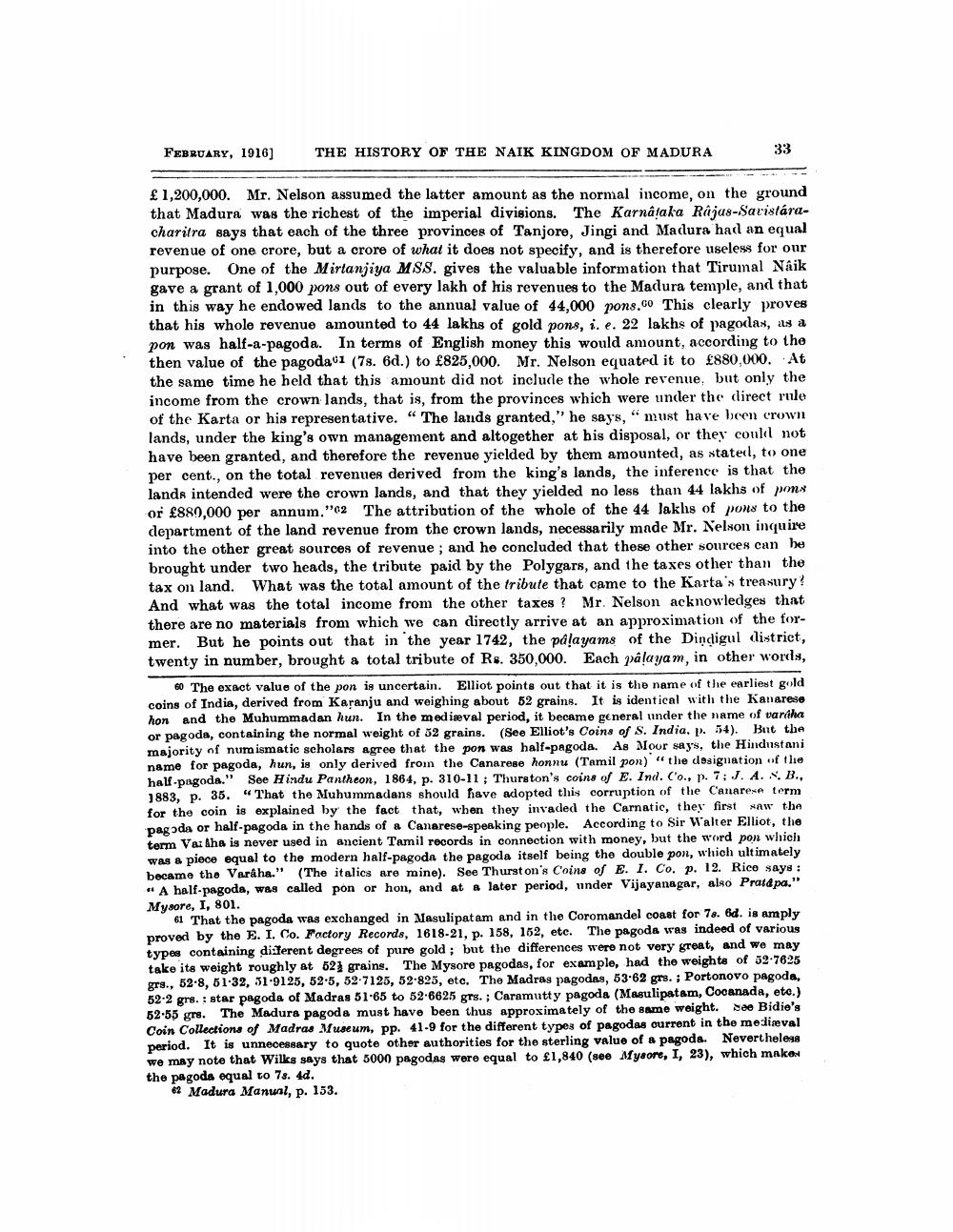________________
FEBRUARY, 1916]
THE HISTORY OF THE NAIK KINGDOM OF MADURA
33
£1,200,000. Mr. Nelson assumed the latter amount as the normal income, on the ground that Madura was the richest of the imperial divisions. The Karnataka Rajas-Savistáracharitra says that each of the three provinces of Tanjore, Jingi and Madura had an equal revenue of one crore, but a crore of what it does not specify, and is therefore useless for our purpose. One of the Mirtanjiya MSS. gives the valuable information that Tirumal Naik gave a grant of 1,000 pons out of every lakh of his revenues to the Madura temple, and that in this way he endowed lands to the annual value of 44,000 pons.co This clearly proves that his whole revenue amounted to 44 lakhs of gold pons, i. e. 22 lakhs of pagodas, as a pon was half-a-pagoda. In terms of English money this would amount, according to the then value of the pagoda (7s. 6d.) to £825,000. Mr. Nelson equated it to £880,000. At the same time he held that this amount did not include the whole revenue, but only the income from the crown lands, that is, from the provinces which were under the direct rule of the Karta or his representative. "The lands granted," he says, "must have been crown lands, under the king's own management and altogether at his disposal, or they could not have been granted, and therefore the revenue yielded by them amounted, as stated, to one per cent., on the total revenues derived from the king's lands, the inference is that the lands intended were the crown lands, and that they yielded no less than 44 lakhs of pons or £889,000 per annum." The attribution of the whole of the 44 lakhs of pons to the department of the land revenue from the crown lands, necessarily made Mr. Nelson inquire into the other great sources of revenue; and he concluded that these other sources can be brought under two heads, the tribute paid by the Polygars, and the taxes other than the tax on land. What was the total amount of the tribute that came to the Karta's treasury? And what was the total income from the other taxes? Mr. Nelson acknowledges that there are no materials from which we can directly arrive at an approximation of the former. But he points out that in the year 1742, the palayams of the Dindigul district, twenty in number, brought a total tribute of Rs. 350,000. Each palayam, in other words,
"102
60 The exact value of the pon is uncertain. Elliot points out that it is the name of the earliest gold coins of India, derived from Karanju and weighing about 52 grains. It is identical with the Kanarese hon and the Muhummadan hun. In the medieval period, it became general under the name of varaha or pagoda, containing the normal weight of 52 grains. (See Elliot's Coins of S. India. p. 54). But the majority of numismatic scholars agree that the pon was half-pagoda. As Moor says, the Hindustani name for pagoda, hun, is only derived from the Canarese honnu (Tamil pon) "the designation of the half-pagoda." See Hindu Pantheon, 1864, p. 310-11; Thurston's coins of E. Ind. Co., p. 7; J. A. S. B., 1883, p. 35. "That the Muhummadans should have adopted this corruption of the Canarese term saw the for the coin is explained by the fact that, when they invaded the Carnatic, they first pagoda or half-pagoda in the hands of a Canarese-speaking people. According to Sir Walter Elliot, the term Va: Aha is never used in ancient Tamil records in connection with money, but the word pon which was a piece equal to the modern half-pagoda the pagoda itself being the double pon, which ultimately became the Varâha." (The italics are mine). See Thurston's Coins of E. 1. Co. p. 12. Rice says: "A half-pagoda, was called pon or hon, and at a later period, under Vijayanagar, also Pratapa." Mysore, I, 801.
61 That the pagoda was exchanged in Masulipat am and in the Coromandel coast for 78. 6d. is amply proved by the E. I. Co. Factory Records, 1618-21, p. 158, 152, etc. The pagoda was indeed of various types containing different degrees of pure gold; but the differences were not very great, and we may take its weight roughly at 521 grains. The Mysore pagodas, for example, had the weights of 52-7625 grs., 52.8, 51-32, 51-9125, 52-5, 52-7125, 52-825, etc. The Madras pagodas, 53-62 grs.; Portonovo pagoda, 52-2 grs.: star pagoda of Madras 51-65 to 52-6625 grs.; Caramutty pagoda (Masulipatam, Cocanada, etc.) 52.55 grs. The Madura pagoda must have been thus approximately of the same weight. see Bidie's Coin Collections of Madras Museum, pp. 41-9 for the different types of pagodas current in the mediaval period. It is unnecessary to quote other authorities for the sterling value of a pagoda. Nevertheless we may note that Wilks says that 5000 pagodas were equal to £1,840 (see Mysore, I, 23), which makes the pagoda equal to 7s. 4d.
62 Madura Manual, p. 153.




